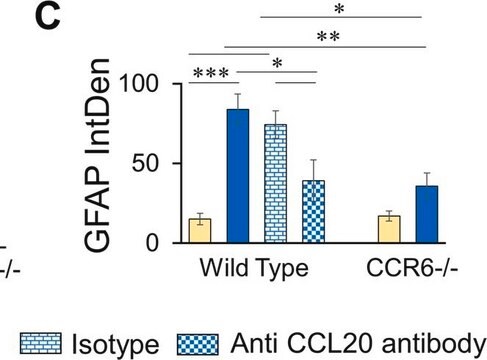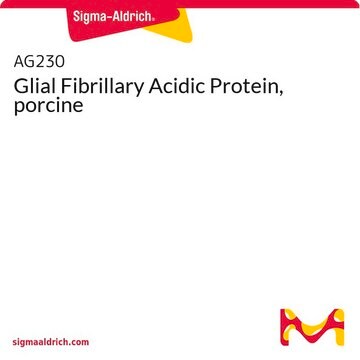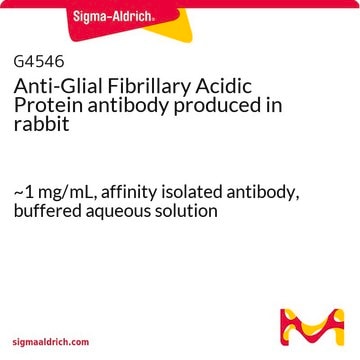AB5804
Anti-Glial Fibrillary Acidic Protein (GFAP) Antibody
serum, Chemicon®
Synonym(s):
glial fibrillary acidic protein
About This Item
Recommended Products
biological source
rabbit
Quality Level
antibody form
serum
antibody product type
primary antibodies
clone
polyclonal
species reactivity
human, bovine, canine, rat
manufacturer/tradename
Chemicon®
technique(s)
immunocytochemistry: suitable
immunohistochemistry (formalin-fixed, paraffin-embedded sections): suitable
western blot: suitable
NCBI accession no.
UniProt accession no.
shipped in
dry ice
target post-translational modification
unmodified
Gene Information
human ... GFAP(2670)
General description
Specificity
Immunogen
Application
Representative images from a previous lot.
Immunocytochemistry:
A 1:1,000 dilution of a previous lot was used in Immunocytochemistry.
Neuroscience
Neuronal & Glial Markers
Quality
Immunohistochemistry(paraffin) Analysis:
GFAP (IHC2078) staining of Human Brain. Tissue pretreated with Citrate Buffer, pH 6.0. Pre-diluted polyclonal antibody, using IHC-Select Detection with HRP-DAB. Glial cells stain strongly (brown).
Optimal Staining with Citrate Buffer Epitope Retrieval: Human Brain
Target description
Linkage
Physical form
Storage and Stability
Handling Recommendations: Upon receipt, and prior to removing the cap, centrifuge the vial and gently mix the solution. Aliquot into microcentrifuge tubes and store at -20°C. Avoid repeated freeze/thaw cycles, which may damage IgG and affect product performance.
Analysis Note
Mouse brain tissue, rat astrocytes, rat neurons.
Legal Information
Disclaimer
Not finding the right product?
Try our Product Selector Tool.
Storage Class
10 - Combustible liquids
wgk_germany
WGK 1
flash_point_f
Not applicable
flash_point_c
Not applicable
Certificates of Analysis (COA)
Search for Certificates of Analysis (COA) by entering the products Lot/Batch Number. Lot and Batch Numbers can be found on a product’s label following the words ‘Lot’ or ‘Batch’.
Already Own This Product?
Find documentation for the products that you have recently purchased in the Document Library.
Customers Also Viewed
Articles
ReNcell neural progenitors are immortalized human neural stem cell lines that can differentiate into neurons, astrocytes sand oligodendrocytes.
Protocols
Step-by-step culture protocols for neural stem cell culture including NSC isolation, expansion, differentiation and characterization.
Our team of scientists has experience in all areas of research including Life Science, Material Science, Chemical Synthesis, Chromatography, Analytical and many others.
Contact Technical Service


















